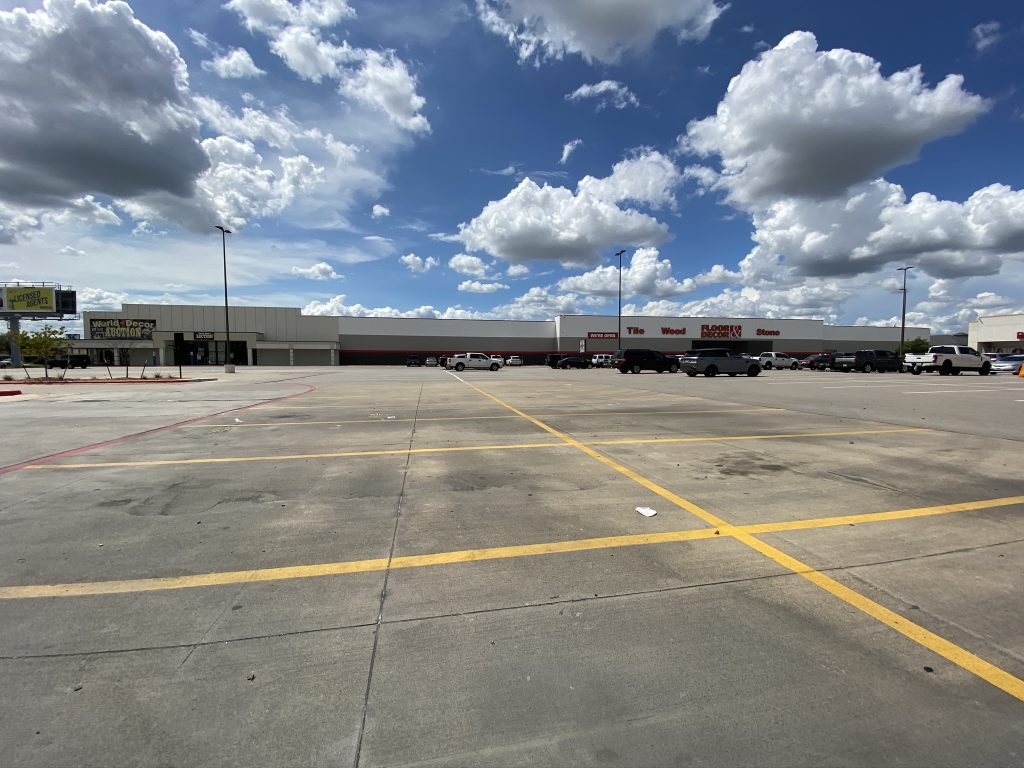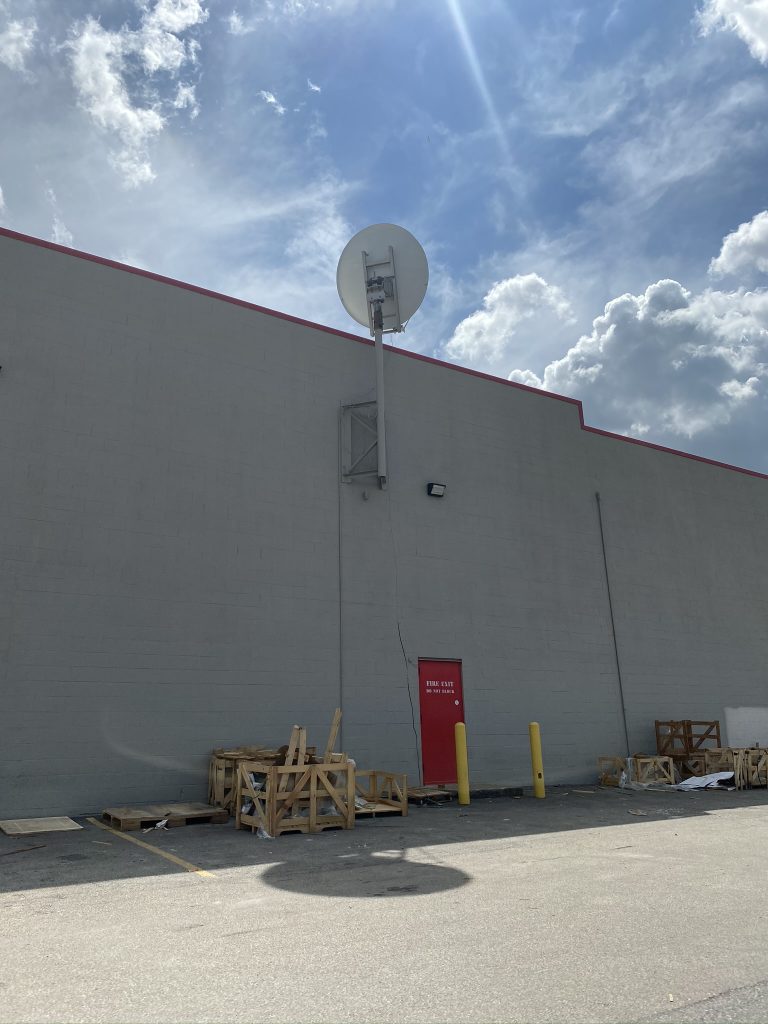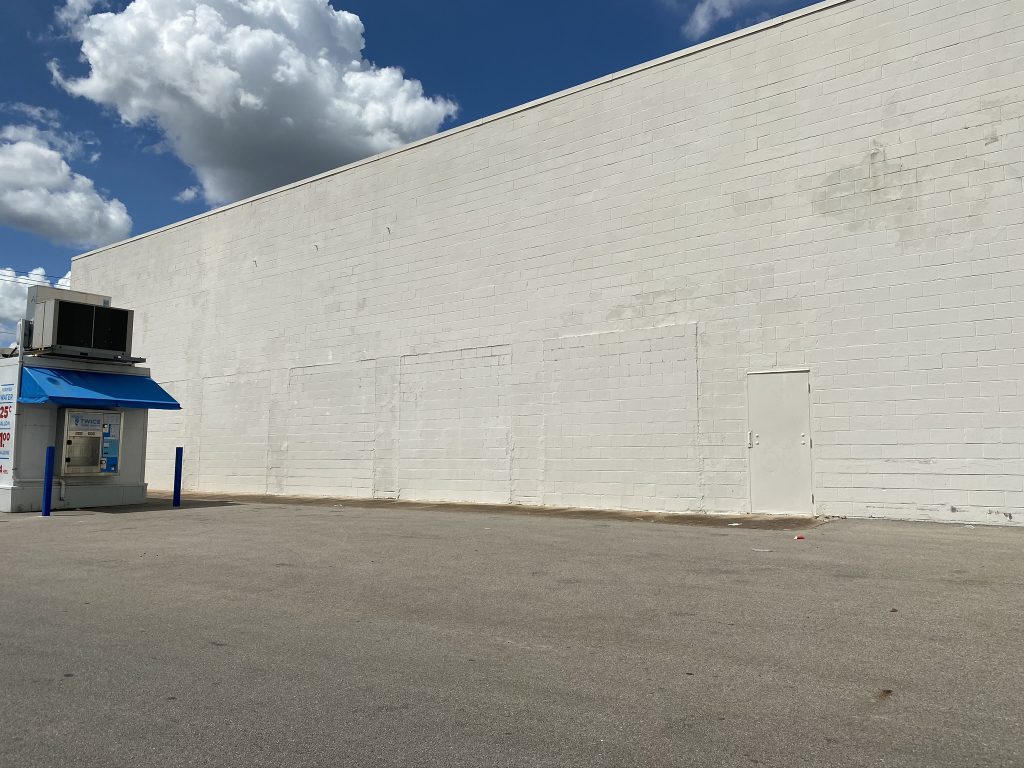Venture Stores Inc. originally started out as a project of the May Department Store Company, a large conglomerate that bought up various department store chains throughout the US. In the late 60s, the company hired a few ex-employees of competing Dayton-Hudson, including Target co-founder John Geisse, with plans to develop an upscale discount department store to keep up with the competition. The first Venture store opened in St. Louis in 1970 and was quickly followed by a few stores throughout the surrounding suburban area and then Chicago. These early stores stylistically resembled Target, using large amounts of red and orange coloring throughout the building, and signs with similar block lettering for the logo, next to a geometric accent. The earliest stores even had their department layouts directly lifted from Target.
May would slowly build up the Venture chain building mostly by building new locations and converting a few individually purchased competitors’ stores. Decisions for new locations were based on markets where May had experienced success with their full-line department stores. By 1985 Venture had made it to over 50 stores, mostly split between Chicago and St. Louis. They also expanded into medium-sized markets in the Midwest, such as Oklahoma, Indiana, and Kansas, going after areas Target did not serve. This careful growth into under-served markets helped to bolster the chain’s success. With the May Company’s 1988 acquisition of Foley’s, executives quickly set their sights on Texas for the next expansion of Venture. In 1990 Venture was spun off as an independent company from May. The idea behind this was that Venture would be able to focus more resources and money directly on its stores instead of having to play second banana to its upscale brothers and sisters.
As Venture expanded into new markets, it tried to emphasize low prices.
On March 27, 1992, Venture announced a huge new plan; they would expand into Texas, giving concrete plans for a total of 10 stores split between Houston and DFW. The movement was not completely unexpected as Venture’s push toward the Southwest had already placed stores in Kansas and, most recently, in Oklahoma. The goal in Texas was 50 stores, over the next five years, including locations in Austin and San Antonio. The chain also planned to open a distribution center in Texas to support these new stores. The new locations were to be “prototypical” Venture locations, coming in around 96,000 Square Feet on Average and carrying a merchandise mix similar to Target. Venture purchased a lot at FM 1960 and TX 249, across from Willowbrook Mall, and made an agreement to lease three former Woolco stores (Almeda, Pasadena, and Texas City). The chain was also in talks for three other sites, including the West Oaks location. One of the first published opinions on Venture was that it wouldn’t do well in Houston. An outside firm noted that while the company would net new jobs, Houston was “over-stored” in terms of discounters and that their opening would eventually result in others closing. Venture also brought with it a bit of a reputation as a seller of knock-offs rather than real brands. While the knock-off comment hurt, the over-stored issue was real, and in fact, how Venture was able to lease three of their former locations from another discounter who fared a similar fate. A few months later, in their next press release, Venture would address this exact issue. Their Chairman stated that Houston wasn’t over-stored and, in fact, had fewer square feet of discount stores per resident than any other city they did business in. The company also indicated that it had no plans to change its merchandising plans for the Midwest. The stores would be more than half clothing, jewelry, and shoes, calling back to their connection to the May Dept Store Company, owner of Foleys. Less than a month later, the store would buy a vacant lot in Sharpstown along the Southwest Freeway, home to the former Royal Coach Inn, with plans to build their seventh location.
In July 1993, the Ventures of Texas held their soft openings. July 25th would be the official grand opening for 10 stores. However, instead of the planned 5 and 5, an imbalance had occurred with 6 stores ready to open in Houston versus only 4 in Dallas. This would be in part due to the ability to easily lease the vacant Woolco space in Houston. The stores were said to be merchandised mostly like other Venture locations. Although to appeal to local culture, they would include more sports accessories, spicy foods, and Western Wear. Actor, Dick Van Patten would even be brought to Houston to promote the new stores. Happy with the progress of their initial stores, Venture would make plans to add 6 more stores in September 1993 only months after their entry into Texas. These new stores would include the first commercial development at the Northwest Corner of what was then Houston’s busiest intersection. The shopping center at Westheimer and Voss would be built with Venture as an anchor tenant. These new stores would be adjusted again to fit the Houston market. They would be pumped up on average by 10,00 Square Feet. The extra space also came with a remerchandising of the stores. Specifically, the number of hard lines in the store was to be increased. Focusing on “warm weather merchandise” Such as sporting goods, lawn, and garden care, and even things like DIY furniture. The Cafe Venture (Cafe Express was already taken in Texas) menu was also adjusted to feature “Southwestern items” probably chili. In late 1994, one of the more prominent locations opened, in Meyerland Plaza. Added as a new anchor during a renovation of one of Houston’s oldest shopping centers. This store clocked in at 108,000 Square Feet, making it the largest ever in the chain. The location would also play host to Houston’s local round of the Nintendo Power Fest. In 1995, plans for Venture would suddenly change.
In July, the company announced that it planned drastically change the image of Venture. Their goal was to ditch the upper-tier discounter image, and shift towards a “value-priced retailer”. Their stores would reduce the overall number of items that they carried, but increase the number of options for what was left, giving room for lower-priced choices. This would largely be supplemented by the expansion of the Venture store brand product selection. This change would be part of a nationwide makeover, which included the closing of 3 stores. Days later, Houston would open their 13th location, Beechnut, and the Beltway. It was promised at the time that no Houston stores would close. However, this would change at the start of 1996 when Venture announced plans to close 10 stores nationwide, and targeted 2 in Houston. Specifically, The Willowbrook and Texas City locations. Despite these two closures, the rest of the Houston stores would continue to operate unabated. In March of 1996 Venture’s remaining Houston stores would hold “grand reopenings” as they were remerchandised. The Houston market was Venture’s third-largest, however, the renovations wiped out many of the adaptations made by the company to better fit Texas. Specifically, home and auto departments were replaced with Health and Beauty Aids. Sporting Goods were also cut to increase soft lines and electronics. With the extra space in the Houston stores, a large emphasis was also put on the Venture Pantry section, which featured packaged grocery items, and basic kitchen supplies. The Texas City store, and Willowbrook would also reopen in the following months. While things were looking a bit better for Venture, there was writing on the wall that the company wouldn’t last long. It started in 1996 with the sale of the Sharpstown parcel, to Allen Samuels Chevrolet. Venture had never ended up building a store there and likely needed the quick cash this sale brought them.
While the sale was a good source of cash, it was endemic to a larger issue. Venture had largely overstepped its bounds, specifically delving into a territory where three companies had been duking it out since the 70s. With enough time and capital behind them, it’s possible that Venture could have survived, but they had limited resources. By the middle of July 1997, Venture made plans to scale back operations outside of their core markets. The Houston stores would see the biggest loss in the chain, with 10 Ventures being sold to Kmart. The stores would remain under Venture control for the next few months to conduct liquidation sales. Kmart would then remodel, and reopen the stores as Big Kmarts. This sale would leave Venture with an odd 3 location setup. Likely as these 3 locations were in competition with existing Kmarts with superior locations or amenities. The first round of closings also hit 5 stores in DFW, and a few stores in Oklahoma. This would leave a total of 8 stores in Texas, however even this would be an overextension. In January of 1998 Venture would file for bankruptcy. Within a month, the remaining 8 Texas stores, including the 3 Houston locations would shut down. Their Corsicana-based Distribution Center would be sold to Kmart, who would continue to run it until their own bankruptcy approximately 5 years later. Many of the final Venture locations were sold to Kmart. However, the company itself would limp along for a few months, until decided to liquidate around March of 1998, ending a 30-year experiment of a Target clone.
Photo Gallery
Store No. | Locations | Description |
|---|---|---|
| #121 | 17717 Tomball Parkway Houston, TX | 1993-1997 First location built, sold to Kmart subdivided between REI, Petsmart, and Best Buy as of 2020 |
| #122 | 14411 Westheimer Rd Houston, TX | 1993-1997 Built by Venture, sold to Kmart, Later Burlington Coat Factory, now Alief ISD Building |
| #123 | 3503 Palmer Highway Texas City, TX | 1993-1997 Built as a Woolco, sold to Wal-Mart then to Kmart, sold to BP used as offices, now subdivided into shopping center (Originally 3401) |
| #125 | 11542 Gulf Fwy Houston, TX | 1993-1997 Built as a Woolco later subdivided with Front Row, Bizmart, and Shoetown, Sold to Kmart, now Floor and Decor (Originally 11540) |
| #126 | 310 FM 1960 W Houston, TX | 1993-1997 Built by Venture, sold to Kmart, subdivided between Fallas Parades (using original entryway) Dirt Cheap, and Planet Fitness |
| #130 | 6802 Spencer Hwy Pasadena, TX | 1993-1998 Built as a Woolco, subdivided with J Brannam, Wal-Mart after 1983. Did not become KMart. Now subdivided among multiple stores |
| #131 | 1001 Bay Area Blvd, Webster, TX | 1994-1997 Built by Venture, sold to Kmart, Later subdivided including Circuit City |
| #135 | 12005 Northwest Freeway | 1994-1997 Built by Venture, sold to Kmart, Later Burlington Coat Factory |
| #138 | 2745 Town Center Blvd Sugar Land, TX | 1995-1997 Built by Venture, sold to Kmart, Subdivided between DSW, Saks, and David's Bridal |
| #139 | 300 Meyerland Plaza Houston, TX | 1994-1997 Built where half of Meyerland Plaza once sat. Sold to Kmart, then Target. |
| #140 | 7600 Westheimer Rd, Houston, TX | 1995-1998 Built by Venture, Became Expo Design Center, Now mostly Academy with small unoccupied space on left. |
| #141 | 8300 W Sam Houston Pkwy S Houston, TX | 1995-1997 Built by Venture, sold to Kmart, now Viet Hoa Market |
| #143 | 4553 Garth Rd. Baytown, TX | 1994-1998 Built by Venture, sold to Kmart, now subdivided mostly Hobby Lobby |






My dad car was keyed a the Westheimer location and we never went back again
I wish I could find interior pics towards the end. I only found a couple from the 80s.
L, I’m not aware of any Venture photos from the 1990s. That said, I do know of some photos taken inside a Kmart in Clive, Iowa that was turned originally a 1990s Venture not unlike many of our Venture stores here in Houston that were turned into Kmarts. This Iowa store has many similarities to our Venture-turned-Kmarts in Houston including the partial drop ceiling design. Since this Kmart lasted a lot longer than the Houston ones did, this store did get some updated decor along the way, but it mostly looks like how our Venture Kmarts looked.
https://flickr.com/photos/fourstarcashiernathan/albums/72157635378613630
The Clive, IA location looks like it was built identically to the Westheimer/Hwy 6 location. When that location closed, it still had an active K-Cafe/Little Caesars at the front that had great popcorn and cotton candy.
The location on Almeda-Genoa is the one that baffles me the most. The interior of Floor & Decor doesn’t look anything like Venture, but I can tell it had the exact same layout as the Westheimer/Hwy 6 store. The ceiling just has weird looking brown rafters instead of the regular open-webbed ones. Your thoughts?
Very interesting question! Almeda-Genoa was in a much older Woolco built building, whereas Highway 6 and Westheimer was a Venture new build. The buildings are actually different in lots of ways, the former Woolco is much larger with their stores running around 300,000 square feet. There is actually a large section of the building that was sublet. Probably close to 50-75,000 sq feet. Also, the Almeda store is an older brick/concrete block building where Highway 6 is a modern tilt wall concrete.
Yes, I agree. I too have noticed all of these changes, however, I can tell both stores had the same identical layouts as Venture. I visited the Floor & Decor store a few years ago and noticed that the restrooms are in the same place as they would have been as Venture, and they look the same as the Westheimer store but with remodeling. There is also a large space between the restrooms and the entrance which is where Kmart customer service would have been, that I noticed too. I feel that while it was an original Woolco build, Venture was trying to make it as identical to their own layout as much as they could. The sublet section to me looks like it may have came later, after Kmart left the building.
The Bellaire-beltway one had Kansas City street maps and Midwest Living magazine for sale at the checkouts. How could any employee not say “uh boss, why do we have these?”
No kidding, I had read multiples times that the stores were reworked and remerchandised to fit our needs. Guess they weren’t paying THAT much attention.